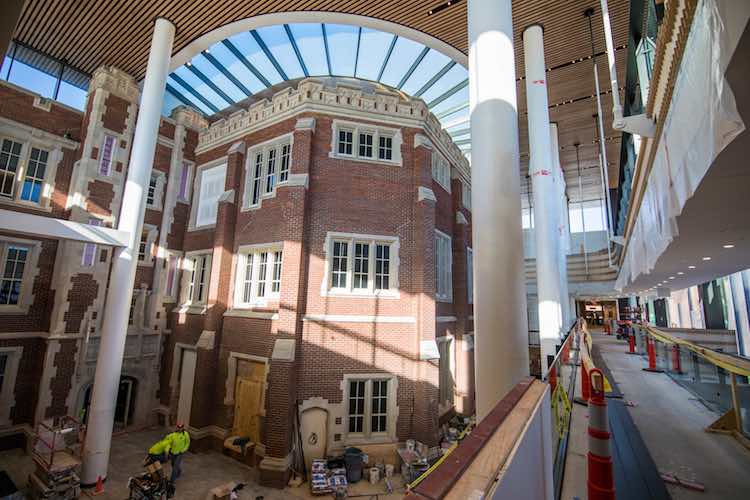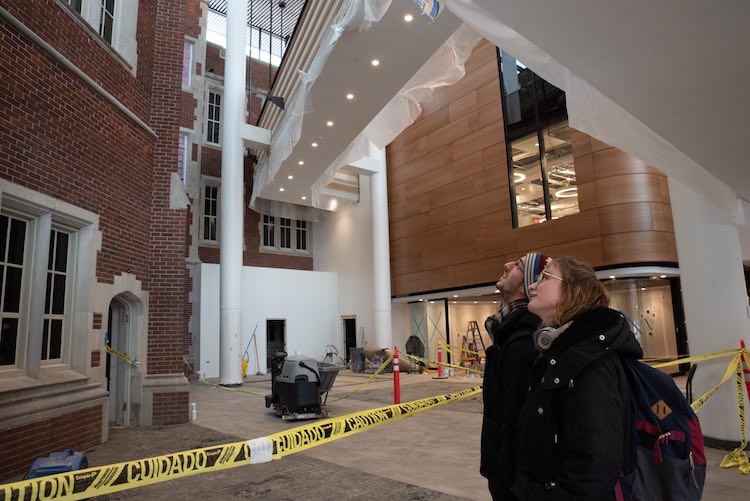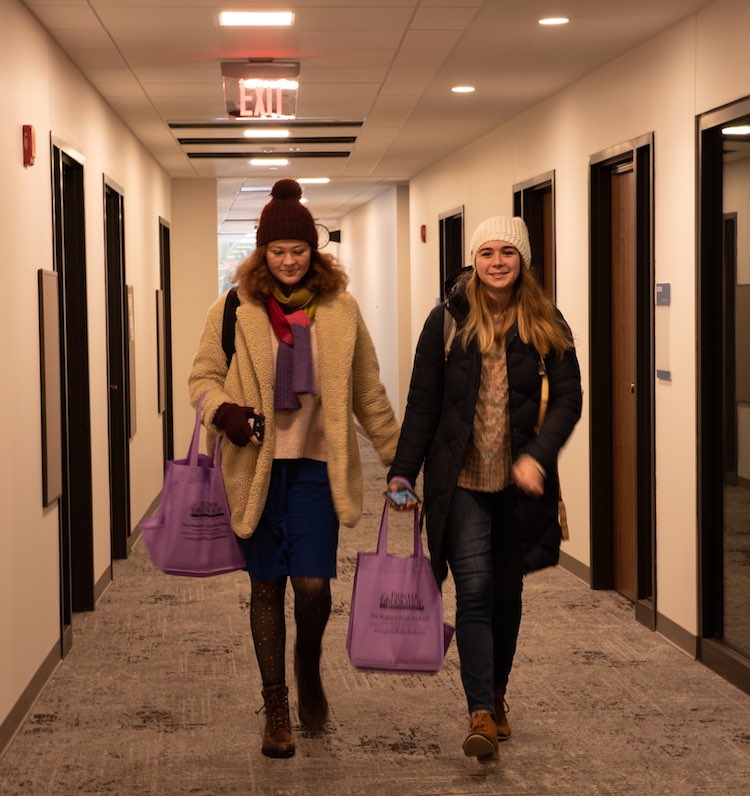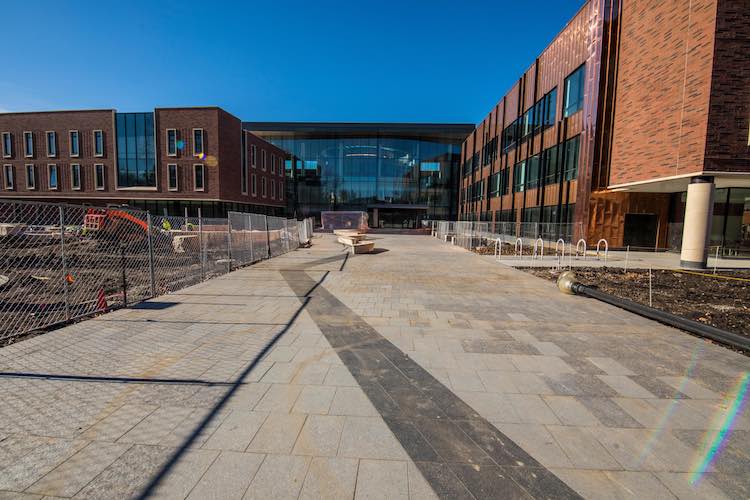Students, faculty adapt to new facility in first week of spring semester classes
GRINNELL, Iowa — Grinnell College’s spring semester classes in humanities and social studies began this week in the newly constructed portion of the new Humanities and Social Studies Center (HSSC).
The $112 million HSSC brings non-fine arts humanities and social studies departments together in one building to creative innovative learning spaces that encourage multi-disciplinary collaboration, active inquiry, student research and “intellectual collisions.”
The HSSC features four pavilions – two new and two renovated – joined by a central, three-story atrium with connecting bridges at floors two and three. Thirty-nine technology-rich classrooms and inquiry labs and 145 faculty offices and dedicated research spaces are grouped into five interdisciplinary neighborhoods. The atrium features the historic ARH Tower and adjoins a cafe, the Institute for Global Engagement and the Data Analysis and Social Inquiry Lab.
Construction workers are doing finishing work in the atrium and other areas with yellow tape indicating safe routes for students and faculty. Once the new portion of the HSSC is completed, the workers will move to the second phase of HSSC construction – renovation and expansion of Alumni Recitation Hall (ARH) and Carnegie Hall. The entire HSSC encompasses 200,799 square feet, including the 147,539-square-foot addition and the 53,260-square-foot renovation and expansion of ARH and Carnegie.
Faculty and students say they are excited about the new HSSC and all that it makes possible. Monessa Cummins, associate professor and chair of classics at Grinnell, recently taught her first class – Roman Archaeology and Art – in the Case Study Classroom.
“It is magnificent,” she said. “Students sit in tiered semi-circular rows facing two large screens on which different high-resolution images can be projected at the same time. I can lecture in the well of the room or move seamlessly to a discussion in which all the students can see and respond to everyone else. After just one class, I can say this classroom is a pedagogical dream come true.”
Grinnell senior Thomas Aldrich, a history and religious studies major from Minneapolis, said, “The HSSC provides rooms that make it easier to engage with the professor and with other students, and the movable furniture in each classroom makes getting into discussion groups easier than ever. The sun-filled atrium reminds you of the history of Grinnell and ARH, seamlessly bringing together new and old.”
Kaylin Kuhn, a second-year student from Bettendorf, Iowa, who plans to major in mathematics, toured the HSSC with a friend on the first day of classes on Tuesday, Jan. 22. “The classrooms look like a perfect learning environment with plenty of natural light,” Kuhn said. “I am very excited to have class here and to spend lots of time exploring and finding new study nooks.”
Abby Frerick, a third-year history major from Cedar Rapids, Iowa, agreed. “The large windows and sleek design make me feel like I am getting a cutting-edge education,” she said. “Also, the variety of study spaces makes the building feel like a blend of dorm comfort and serious academia.”
Jim Swartz, Dack professor of chemistry and co-chair of the College’s Building Advisory Committee, also strolled through the HSSC on the first day of classes. “I was struck with how many student groups I saw using informal gathering spots and how many faculty members who stopped me on the hallway and commented on how wonderful the classrooms are,” he said.
“After six years of planning, design and construction,” Swartz added, “it is thrilling to see our dreams materialized with spectacular new classrooms, students interacting with one another and with faculty members in common spaces, and faculty members interacting across disciplines as they are in neighborhoods mixed together and not siloed into departments.”
The energy-efficient HSSC is designed to utilize only 45 percent of the energy used by a similar-sized building that just meets today’s building energy code, said Rick Whitney, director of facilities management at Grinnell. The facility’s green features include:
- A heat-reflective roof
- A partial green roof to be added this spring
- Storage of rainwater collected from most of the roof area and bioswales around the building that ensure no additional rainwater will flow into the municipal storm sewer system
- Collected rainwater used for irrigation and flushing toilets
- Energy-efficient LED lighting
- Geothermal heating and cooling via geothermal well field, which has 220 wells that are 275 feet deep
The estimated completion date for the entire HSSC, including renovation and expansion of ARH and Carnegie Hall, is summer 2020. EYP Inc. of Boston designed the HSSC with construction administration assistance from OPN Architects of Des Moines. The Iowa office of McGough Construction is construction manager for the HSSC and Grinnell’s new $12 million Admission and Student Financial Services facility, which opened last fall.

The three-story atrium, which is undergoing finishing work, is centered around the historic tower of Alumni Recitation Hall.








